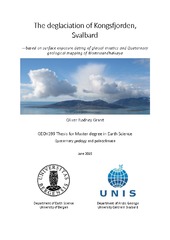| dc.description.abstract | Surface exposure dating via 10Be cosmogenic nuclide dating is used, alongside Quaternary geological mapping of landforms and sediments, to reconstruct the course of deglaciation following the Late Weichselian Glacial Maximum in Kongsfjorden, northwest Spitsbergen, Svalbard. Kongsfjorden hosted a fast-flowing paleo-Ice Stream at the Last Glacial Maximum, draining an ice dome over northwest Spitsbergen. One research aim is to resolve the nature of glacial retreat in the fjord, questioning whether it was a rapid collapse of the ice stream. A secondary objective is to couple the nature of retreat to the dynamic behaviour of the Svalbard-Barents Sea Ice Sheet during deglaciation. Blomstrandhalvøya is a ca. 16 km2 island close to the centre of Kongsfjorden, and can be considered a large roche moutonnée, overridden during repeated glacial advances toward the shelf-edge west of Kongsfjorden through the Quaternary. The island provides an ideal location to study landforms and sediments associated with the Late Weichselian glaciation and subsequent Holocene interglacial period. Detailed mapping reveals a periglacial dominated landscape development through the Holocene, with the north and east of the island affected by the Little Ice Age glacial advance and 20th Century surge activity of Blomstrandbreen. Surface exposure dating of glacial erratics on Blomstrandhalvøya shows the initiation of retreat at ca. 15.6 ka, and continued lateral retreat through the Bølling-Allerød. A trimline-moraine complex observed on the southeast of the island yields a mid-Younger Dryas exposure age, and a number of samples produce similar ages below the trimline elevation, it is thus suggested that the trimline-moraine complex represents a Younger Dryas ice marginal position in the fjord. This is consistent with previous reconstructions in western Spitsbergen which show a suppressed marine limit through the Younger Dryas. The secondary field area, Ossian Sarsfjellet at the head of the fjord, reveals deglaciation ages within the Younger Dryas, thus suggesting a dynamic thinning of the remaining ice cap over central-eastern Spitsbergen. Clusters of exposure ages, combined with published exposure and radiocarbon dates, allowed for an ice-surface reconstruction for the paleo-ice stream in Kongsfjorden, and subsequently used to illustrate the course of deglaciation in the fjord at six approximate time slices (16.6 ka, 15.6 ka, 14.5 ka, 12.7 ka, 0.02 ka, and present). The reconstructed nature of the deglaciation of Kongsfjorden significantly builds on previous work and conceptual models in the fjord and neighbouring areas in north/west Spitsbergen, highlighting the dynamic behaviour of the fjord glacier during retreat, and reflecting the upstream behaviour of the Svalbard-Barents Sea Ice Sheet following the Late Weichselian Glacial Maximum. | en_US |
